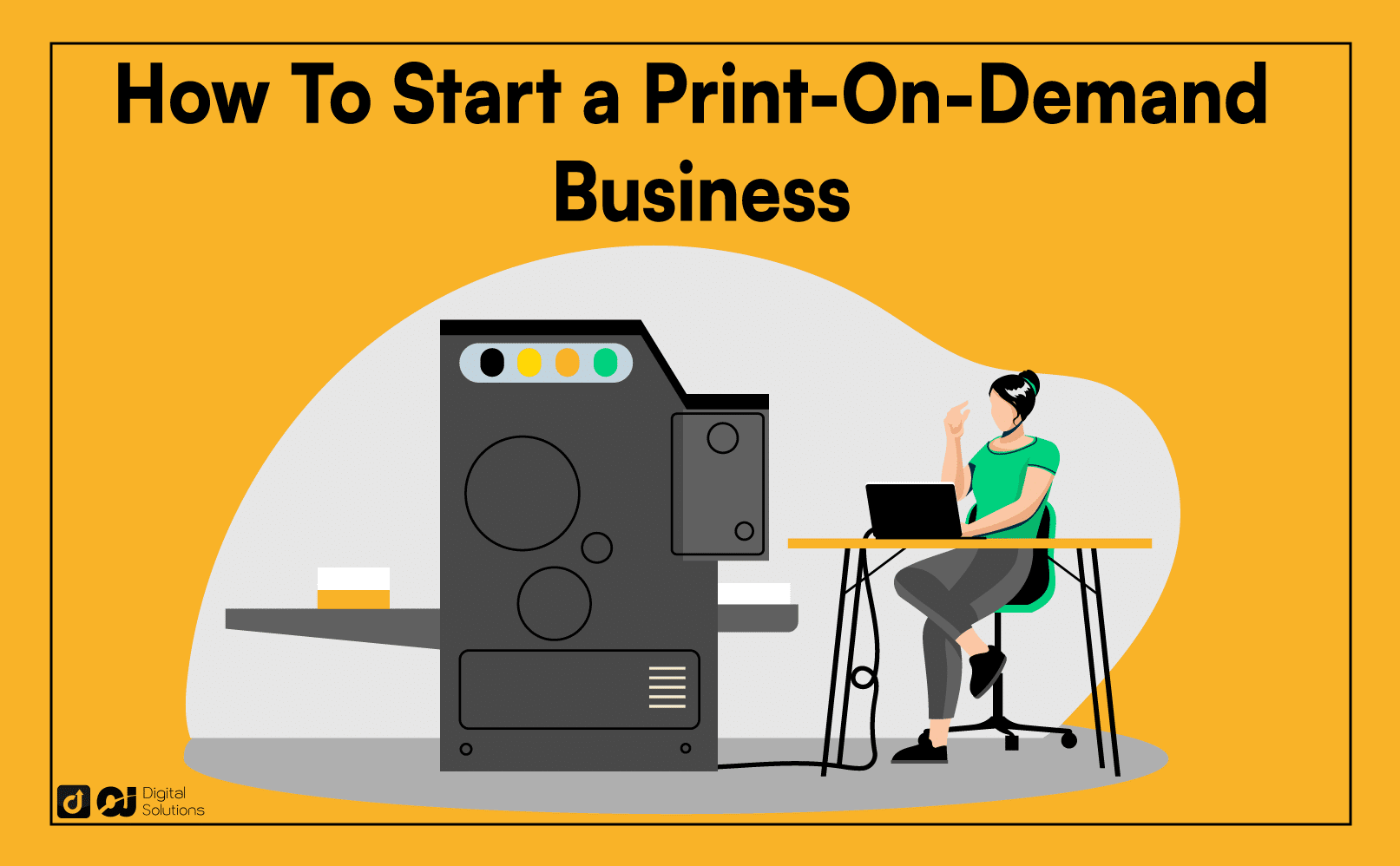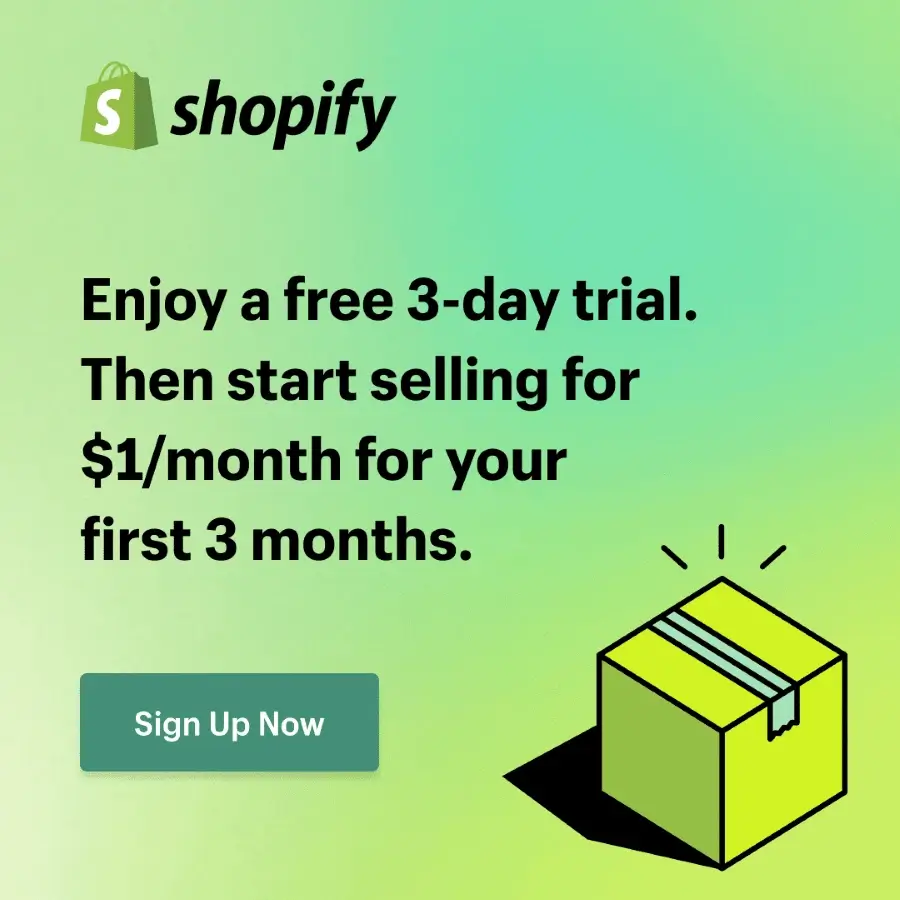Are you a creative entrepreneur or an aspiring designer? You can choose from many business models, but print-on-demand could be ideal.
The print-on-demand model lets you create custom products and sell them online. The best part is you don’t need significant capital to do it.
If you want to start selling personalized products, you’ve come to the right place.
I wrote this step-by-step guide to teach you how to start a print on demand business.
Let’s begin.
What Is a Print-On-Demand Business, and How Does It Work?
The print-on-demand (POD) business model lets you create and sell custom-designed products without needing inventory.
When a customer orders, your print-on-demand service partner will print the product and ship it to your customers directly.
Here’s how print-on-demand businesses work.
- Decide on the items you want to offer, like shirts, hoodies, mugs, towels, art prints, blankets, pillowcases, and many more.
- Create or customize your designs using graphic design software or other online tools.
- Partner with print-on-demand sites like Printify or Printful that print-on-demand services and integrate with Shopify, Etsy, Amazon, and other platforms.
- Set up a Shopify online store or use third-party marketplaces to sell your products.
- List your products. Upload your designs and product information, including descriptions, pricing, and variations, to your online store or marketplace.
- Receive orders. When a customer orders, your online store or marketplace will send the order details to the POD service provider.
- Your print-on-demand service partner will print the design on the customer’s chosen product, package it, and prepare it for shipping.
- The print-on-demand service will ship the product directly to the customer’s address using your own brand and packaging.
- Track the status of orders and handle customer inquiries through your own store or marketplace.
You can use print-on-demand sites to accomplish the following tasks:
- Test the market for new products before committing to a large production run. You can create a limited quantity of items to gauge demand and gather feedback.
- Showcase and sell artwork and designs on various products like t-shirts, mugs, and more without investing in inventory or managing fulfillment.
- Offer your customers various customizable products without investing much money upfront in inventory and production equipment.
- Create personalized gifts or merchandise for special occasions like birthdays, anniversaries, or weddings.
- Create merchandise for bloggers, podcasters, and YouTubers featuring their logo or brand, allowing them to monetize their online presence and engage with their audience.
- Expand your product offerings, test new designs, and add new items to your store without worrying about production logistics.
- Create and sell event merchandise for event organizers and promoters, such as t-shirts, posters, or tote bags.
- Express your creativity and create unique, one-of-a-kind items to design and order personalized products to sell.
How To Start a Print-On-Demand Business
Here’s how to start a profitable print-on-demand business.
Step 1: Determine Your Niche.
Choosing the right niche should be the first step in your print-on-demand business plan.
A niche is a specific and targeted market segment.
Serving a niche involves creating unique and customized products to meet the needs and preferences of a specific group of customers.
Given the convenience of the print-on-demand business model, it can be tempting to sell a wide range of products and try to target different niches.
However, tailoring your offerings to cater to a specific audience can help you stand out in a competitive market.
When selecting a niche for your POD store, consider your interests and what you think will sell. Passion for your niche will drive creativity, motivate you, and let you foster a deeper connection with your target customers.
Combining your interests with market research can lead to innovative and appealing products that set you apart.
Here are some print-on-demand business ideas.
- Nature and Wildlife
This niche is ideal for nature lovers who can design and offer products like nature-inspired t-shirts, eco-friendly water bottles, and nature-themes home décor. - Fitness and Workout Gear
This niche is great for fitness enthusiasts who want to create custom workout apparel, gym accessories, and motivational fitness posters. - Book and Literature Fans
This niche suits bookworms who want to design book-themed tote bags, literary art prints, and reading-inspired mugs. - Travel and Adventure
This niche is perfect for travel enthusiasts who can offer travel-inspired phone cases and adventure-themed and wanderlust apparel. - Pets
This niche is for animal lovers who want to design personalized pet accessories, pet-themed clothing, and cute pet-related merchandise. - Spirituality and Mindfulness
This niche is great if you’re interested in mindfulness. You can create meditation-themed products, inspirational wall art, and spiritual apparel.
Step 2: Decide What You Want To Sell.
Conducting product research can help you determine what to sell in your POD store.
Evaluate which designs and products are selling well and gaining popularity in your chosen niche. You can add a unique twist to existing ideas to make them stand out.
Here are some print-on-demand products you can sell.
- T-shirts
- Coffee mugs
- Tumblers
- Hoodies
- Bags
- Posters
- Phone cases
- Notebooks
- Wall art
Follow these tips to decide what to sell.
Use Product or Keyword Research Analysis Tools.
Use product and keyword research analysis tools to identify trends and top-selling products. Paid tools like Sell The Trend can offer valuable insights into market demand and popular designs.
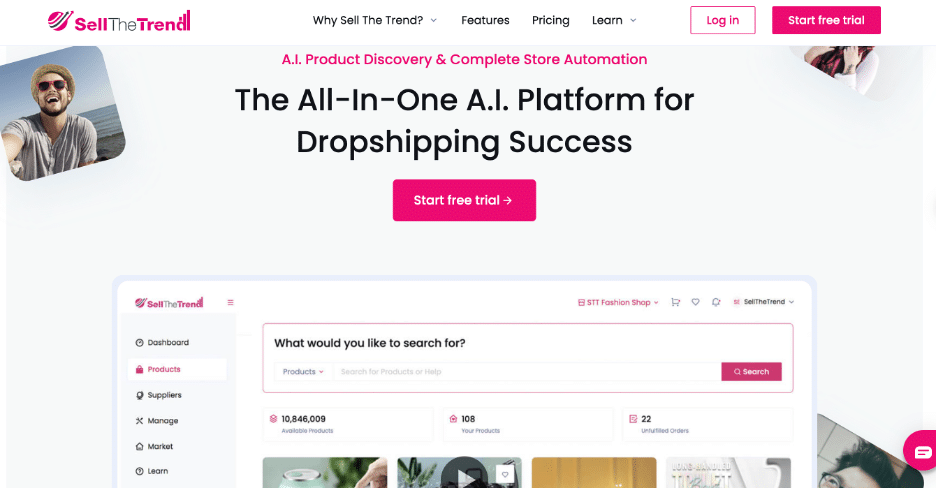
Do Manual or Free Product Research.
Perform manual and free product research using platforms like Google Trends, Etsy, Amazon, and eBay. Look for items that sell well and attract customers’ attention.
Search Social Media.
Explore social media platforms to find viral designs that can inspire your creations.
Avoid Copyrighted Products.
Make sure you avoid copyright infringement by creating your own designs. While you can draw inspiration from existing designs, you can’t duplicate someone else’s work.
Redesign existing concepts using your style to make them unique and legally sellable.
Avoid Using Trademarked Material.
Do not use trademarked material in your designs. Conduct a trademark search in each country you plan to sell to avoid legal issues.
Each country has a specific trademark search engine. Visit the official website of the trademark office in the country you wish to search for trademarks.
For example, you can use the United States Patent and Trademark Office (USPTO) website to verify US trademarks.
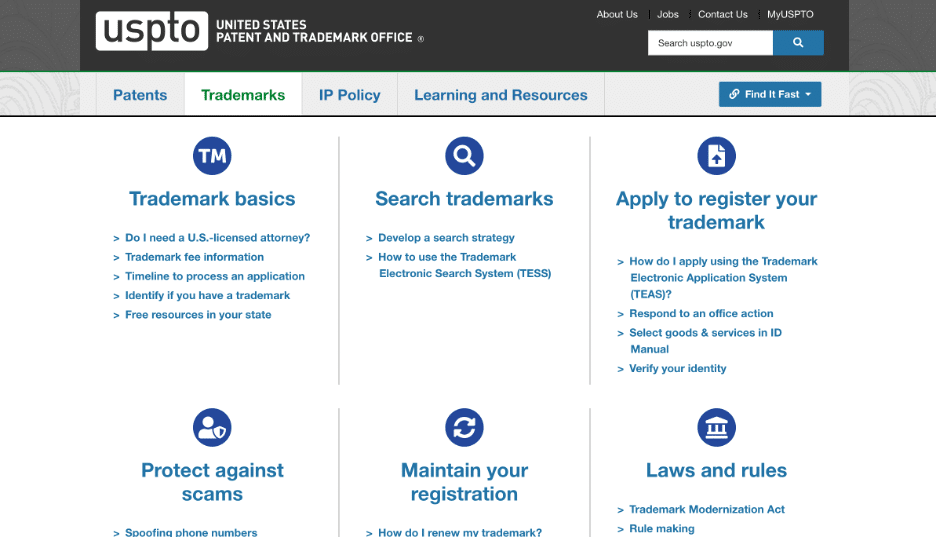
By conducting thorough research and staying within legal boundaries, you can confidently select the best-selling products and create original designs that resonate with your audience in the print-on-demand industry.
Step 3: Create Your Designs.
Creating eye-catching and original designs is essential for the success of your print-on-demand venture.
Whether you’re a talented artist or a non-designer looking to collaborate with design experts, there are various methods and sources to draw inspiration from and create designs that resonate with your target audience.
Consider the following methods when looking for design inspiration for your print-on-demand products.
Use DIY Design Software.
Use digital art software like Canva or Adobe Photoshop to bring your artistic vision to life. These tools offer a wide range of features to design unique and captivating artwork.
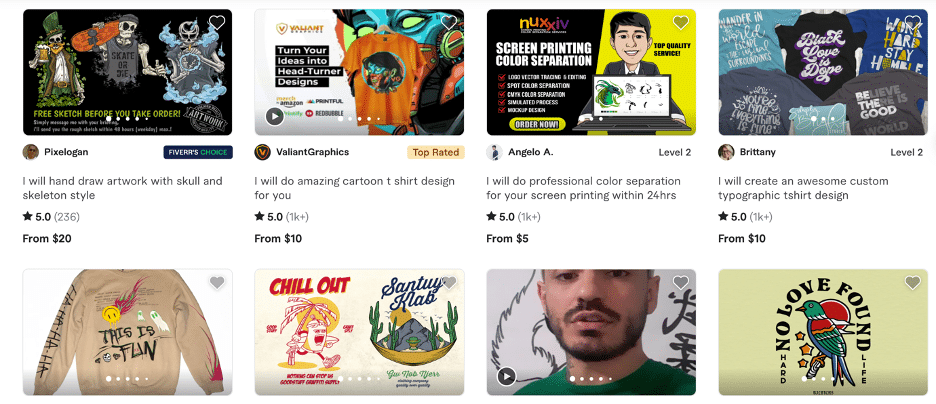
Hire Freelance Designers.
If you’re not an artist, you can hire a freelance professional designer from platforms like Fiverr or Upwork. These platforms connect you with talented designers who can create customized designs according to your specifications.
Use Free Image Sites.
If you’re not well-versed in design, explore free image sites, such as stock image websites, to find visually appealing images to use as foundations for your designs.
Note: Ensure you have the necessary rights to use these images commercially.
Look for Design Inspiration.
Look for design inspiration from various sources to fuel your creative process.
- Your Competitors
Study your competitors’ print-on-demand stores, look for design trends, and find opportunities to differentiate your products. - Marketplaces
Browse through successful designs on Etsy, Pinterest, and Teespring to see what’s trending and popular among customers. These platforms showcase a wide variety of unique and creative designs.
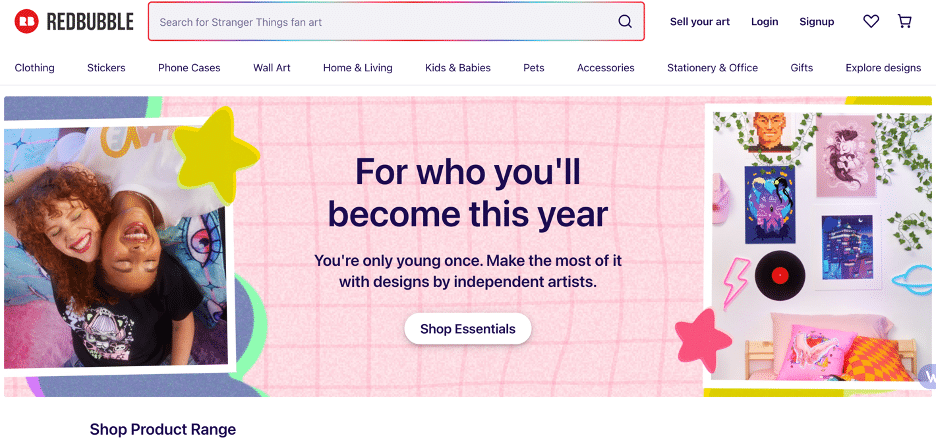
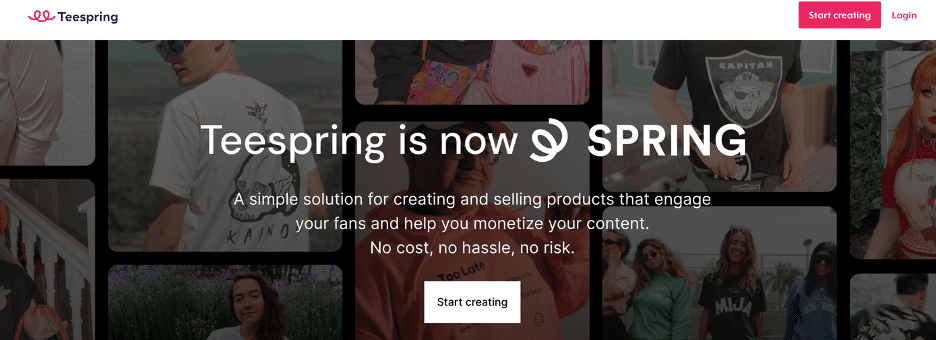
Step 4: Choose Your Print-on-Demand Partner.
| Platform | Best Features | Cons | Monthly Price |
|---|---|---|---|
| Gelato | A free version, sustainable practices, an intuitive website and design editor, a global fulfillment network, live shipping rates, automatic file upload for personalized orders | Limited product selection, needs subscription to access stock images, no warehousing and same-day fulfillment | Starts at $14.99 monthly |
| Printful | No monthly fees, easy to use, high-quality print products, options for custom branding, offer product personalization, sustainable practices, and integration with many ecommerce platforms | Smaller product catalog than other POD services, relatively expensive, no phone support, hidden costs, can’t choose your print location | No monthly fee |
| Printify | A free version, high-quality products, 90 order fulfillment facilities, a large and global network of print providers, offers quality checks, reprints, and refunds, more than 250 products | Slow customer service, limited customization and branding options, limited platform and online marketplace integrations | Starts at $24.99 monthly |
| Sellfy | Free trial, easy to use, integrates with various platforms, customizable storefront themes, sells both digital and physical products | Limited print-on-demand options, lack of return policy information | Starts at $19 monthly |
| Jetprint | No monthly fees, high-quality products, different payment integrations, great customer service, practical lab design, wide product selections | Some delays in the mockup engine, quality control issues for some users, and language barriers with some suppliers | No monthly fee |
Let’s explore some of the most popular print-on-demand companies and sites.
Gelato
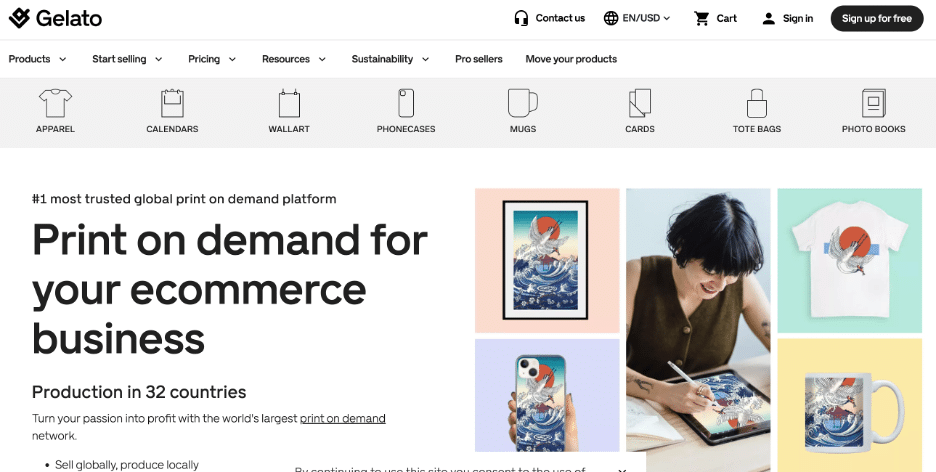
Gelato offers customization options for various products, including clothing, accessories, and home goods. They’re environmentally conscious, using zero-plastic packaging and 100% recycled paper packing slips.
Their standout feature is extensive customization options, enabling customers to personalize their chosen product.
The platform operates globally and partners with local printing facilities in different countries for efficient and cost-effective shipping. But, shipping addresses should be in the local language of countries like China, Japan, and South Korea.
However, Gelato’s global reach may not be as extensive as other print-on-demand companies.
Printful
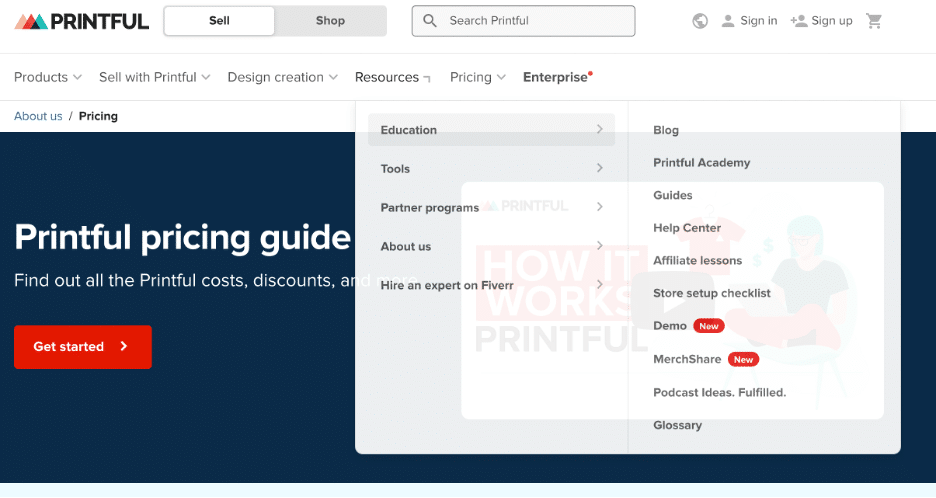
Printful is a great option if you want a wide range of customizable products and high-quality items, like t-shirts or hats.
They provide worldwide services, with shipping rates depending on the destination and package weight. You can choose from standard and express shipping options.
Printful eliminates the need for inventory management, saves storage space, and reduces overstocking risks—Printful handles printing, packaging, and shipping so you can focus on growing your business.
However, some concerns include potential additional costs for customization features like custom-printed inside labels or premium images. You should consider these charges when setting prices to maximize profitability.
Printify
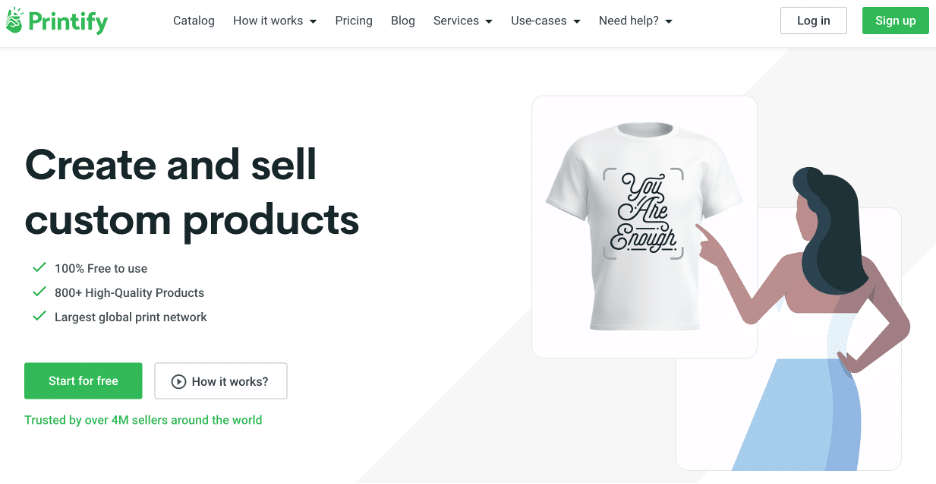
Printify is a print-on-demand platform that connects online shops to a network of over 80 print providers with over 110 fulfillment centers worldwide.
They offer various customizable products, including apparel, home decor, and accessories. Printify integrates with e-commerce platforms like Shopify, Etsy, Wix, WooCommerce, and eBay.
Printify business technology automates print-on-demand services, making it easy to handle peak holiday seasons with its wide network of partners and automatic routing functionality.
They offer some of the lowest prices in the industry because print providers compete to win your business. Printify also has Premium and Enterprise plans with massive discounts for businesses.
Printify’s technology automates print-on-demand services, making it easy to handle peak holiday seasons with its vast network of partners and automatic routing functionality.
Sellfy
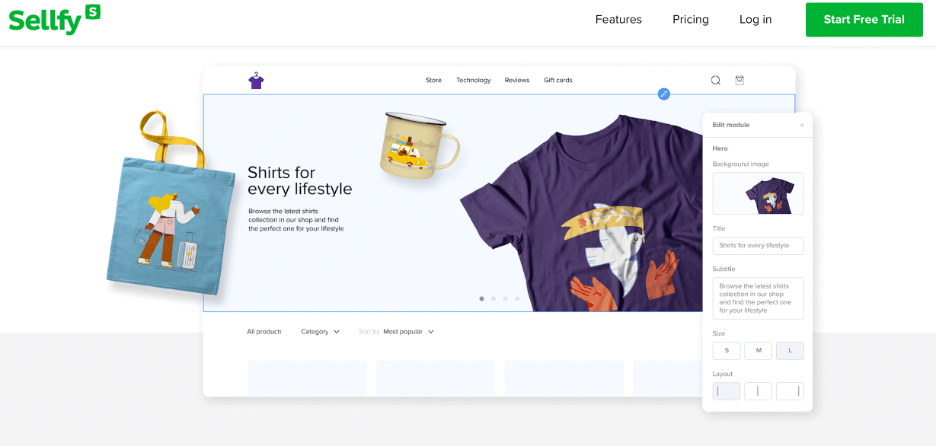
Sellfy focuses on digital products like ebooks, music, and graphics. If you’re looking for physical product offerings or a high level of customization, you might want to explore other print-on-demand companies.
This print provider is easy to work with and provides a fully customizable storefront, advanced customization options, secure file hosting, automated product delivery, sales tracking and analytics, custom domain settings, and more.
Sellfy lets you sell digital and physical products, digital subscriptions, or print-on-demand merchandise online. It’s an excellent platform for entrepreneurs and creators new to ecommerce and looking for a straightforward solution.
JetPrint
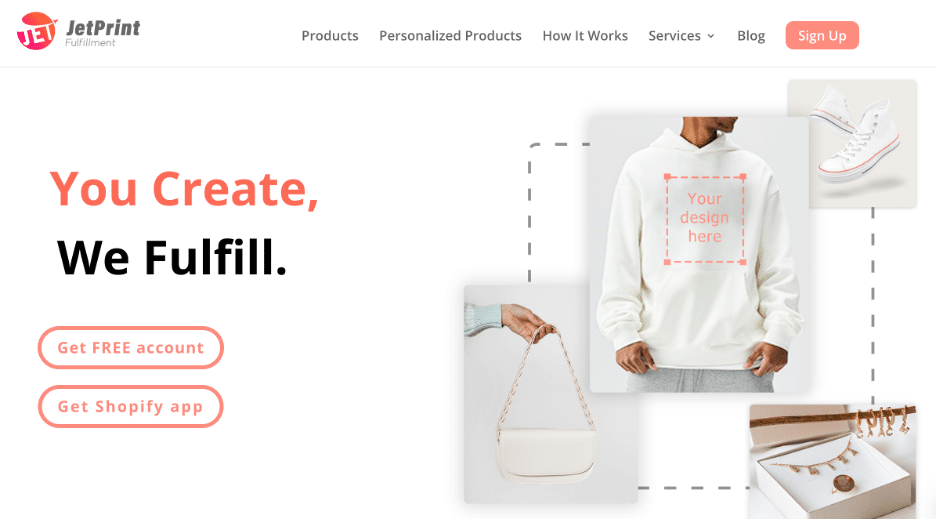
JetPrint stands out for its extensive customization options, allowing customers to personalize their items with custom designs, text, or images. This lets you create unique products that match your specific needs.
When it comes to shipping, JetPrint ensures reliable and efficient delivery, working with trusted partners for safe and timely shipping. You can count on getting your products within a reasonable time, enhancing the overall shopping experience.
JetPrint offers an impressive range of products, covering apparel, accessories, home decor, and more. The diverse selection allows you to curate a unique product lineup.
The user-friendly website makes it easy to design and order customized products. Plus, their commitment to high print quality ensures customer satisfaction.
However, customization may come with extra costs, so evaluate your budget and decide if it’s worth it.
JetPrint offers competitive rates, making customization accessible to many print-on-demand sellers.
Step 5: Choose Your Ecommerce Marketplace or Platform.
The next step to starting a print-on-demand business is selecting an ecommerce platform for your store.
Here are your options.
Start Your Own Store.
If you want more control over your business, I recommend starting your own store. This option allows you to sell any product you desire and enables you to build your own brand.
The best part is you won’t have to share revenue with a marketplace.
I recommend setting up a Shopify store.
Shopify is the best ecommerce platform to use when starting your own business via print-on-demand because most, if not all, POD suppliers have seamless Shopify integrations.
Shopify also integrates with marketplaces like Etsy, Amazon, and eBay if you want to sell your products there.
Sell on an Existing Platform.
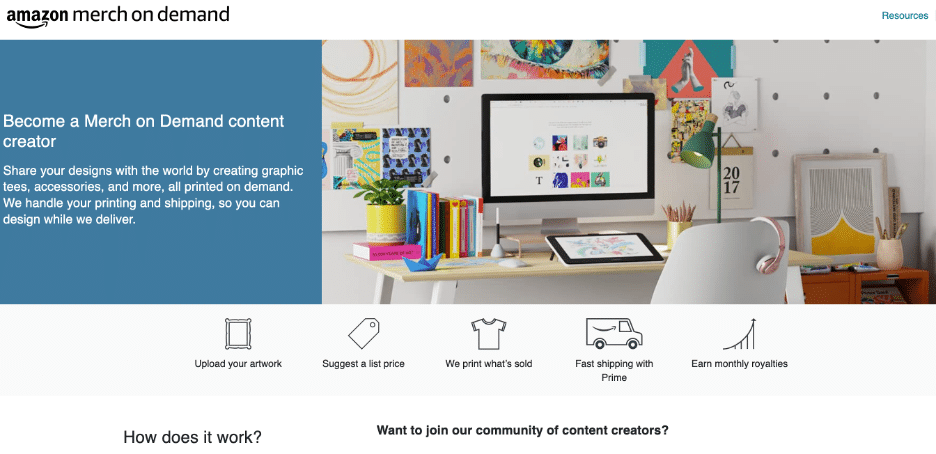
This method lets you start selling custom products with your own branding in only a few clicks.
You can start a print-on-demand business on platforms like Etsy, Merch by Amazon, or Redbubble.
However, selling on these print-on-demand marketplaces has some limitations. You’ll have to compete with other designers, and your product options may be limited to what your chosen marketplace allows.
Additionally, the platform will take a portion of each sale, reducing your margins and income potential.
Step 6: Set Up Your Print-On-Demand Store.
Setting up print-to-order store involves several steps that will vary according to your chosen platform.
Here are some general steps for how to set up a print-on-demand store.
Think of a Store Name.
Choose a unique and catchy name representing your brand and the products you’ll sell. Ensure the name is easy to remember and spell.
Pick a Theme.
Select a visually appealing and user-friendly theme for your store. Themes determine your website’s overall look and feel, so pick one that aligns with your brand and enhances the shopping experience for your customers.
Design Your Website.
Customize your website to reflect your brand identity. Add your logo, choose a color scheme, and arrange product categories logically and in order. Aim for a clean, professional design that makes your custom products stand out.
Integrate Your Print-On-Demand Supplier to Your Ecommerce Store.
This step is crucial as it involves integrating your chosen print-on-demand supplier with your online business. Depending on the platform, this integration process may vary.
Follow the instructions provided by your print-on-demand supplier to connect your store to their system, enabling seamless order processing and fulfillment.
Set Up Product Pages.
Create product pages for each item you plan to sell. Include high-quality images, detailed product descriptions, pricing, and any customization options you offer. Ensure that the product pages are easy to navigate and showcase your products effectively.
Set Up Payment Gateway.
Choose a secure and reliable payment gateway that allows customers to purchase smoothly. Popular options include PayPal, Stripe, and Square. Test the payment process to ensure everything works correctly.
Configure Shipping Settings.
Determine your shipping options and rates based on your print-on-demand supplier’s shipping capabilities and costs. Provide clear shipping information to customers, including estimated delivery times.
Add Policies and Contact Information.
Create and publish important policies on your own website, such as refund and return policies. Include clear contact information, like a customer support email or phone number, to facilitate customer communication.
Test Your Store.
Before launching, thoroughly test your store’s functionality. Make sample purchases, check the checkout process, and verify that your print-on-demand integration works correctly.
Remember that while these are general steps, each e-commerce platform may have its own specific procedures and features. Always refer to the platform’s documentation and guidelines for detailed instructions on setting up your print-on-demand company.
Step 7: Add Your Listings To Your Store and Optimize Them.
Let’s break this step down into two. First, let’s discuss adding listings to your storefront.
How To Add Listings to Your Storefront
Product Selection
Choose the products you want to sell and create listings for each. Add product names, descriptions, images, and pricing.
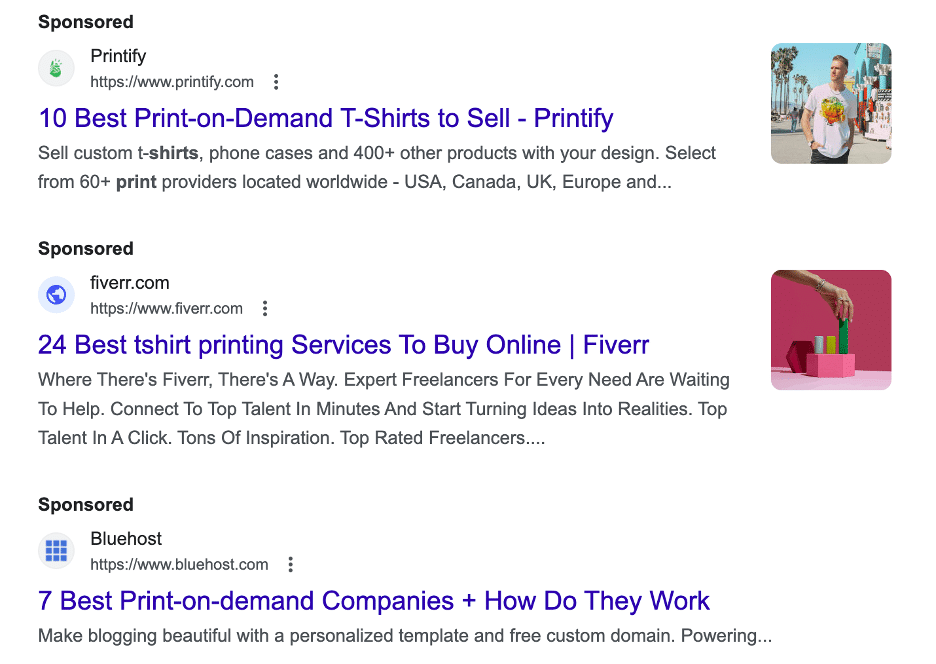
Product Descriptions
Write clear and compelling product descriptions highlighting each item’s features and benefits. Use keywords that potential customers may search for to improve search engine visibility.
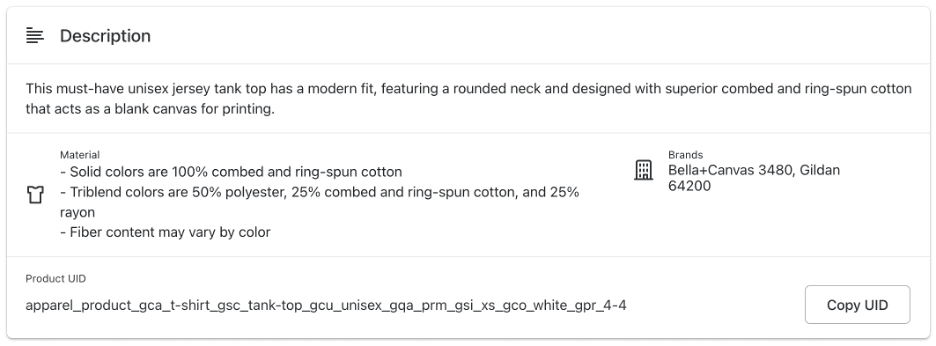
Images
Use high-quality images that showcase your custom products from different angles. Clear and appealing visuals can significantly impact a customer’s purchase decision.
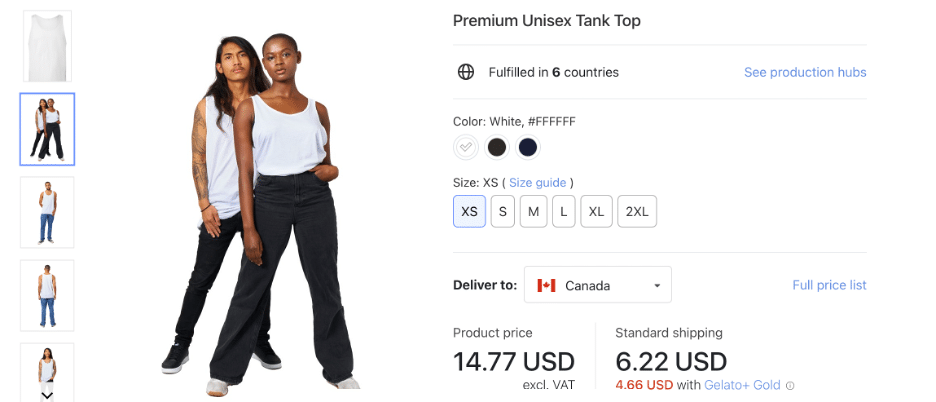
Pricing
Set competitive and reasonable prices for your products. Consider factors like production costs, shipping fees, and desired profit margins while determining the pricing.
How To Optimize Listings
Keyword research
Conduct keyword research to identify popular and relevant search terms related to your products. Incorporate these keywords into your product titles and descriptions to improve SEO and attract potential buyers.Product titles
Craft descriptive and concise product titles that include important details and keywords. Avoid using generic titles and be specific.Example: White Crew-neck T-shirt With (Insert your design description here)
Product descriptions
Optimize your product descriptions with relevant keywords, bullet points, and organized formatting. Use persuasive language to highlight the product’s unique selling points.Tags and categories
Utilize relevant tags and categories to make it easier for customers to find your products when browsing or searching the platform.Images (and videos if applicable)
Create mockups that accurately show your designs on a specific item (e.g., t-shirts, jackets, bags, etc.). Ensure your product images are high-quality and well-lit and showcase the product’s details. Include multiple photos to provide a comprehensive view.Pricing strategy
Regularly review your pricing strategy to remain competitive while maintaining a reasonable profit margin.Customer reviews
Incentivize customers to leave reviews for your products. Reading positive reviews builds trust and encourages customers to purchase.
Every ecommerce platform has specific guidelines or features for listing and optimization.
Familiarize yourself with your chosen platform’s policies and recommended practices to ensure your listings comply with their requirements.
Regularly monitor and update your listings based on customer feedback and changing market trends to improve your store’s performance and sales.
Step 8: Price Your Products.
Pricing print-on-demand products involves several steps to ensure you cover your product costs and make a profit. Here’s how you can do that:
Understand Your Costs.
Consider expenses related to printing, product sourcing, and customization. Gather all relevant costs to estimate print-on-demand prices accurately.
Determine the design cost per item by dividing the total cost by the number of designs you expect to sell. This baseline will help you calculate the price per unit.
Consider Market Demand and Seasonality.
Adjust prices based on demand and seasonality. For example, raise prices for hoodies and beanies during fall and winter and lower them in the summer.
Understanding market demand ensures you set competitive prices, encouraging your target market to purchase.
Research Your Competitors.
Compare your prices with other sellers offering similar products to gain insight into market standards and customer expectations, helping you make informed pricing decisions.
Determine Your Desired Profit Margin.
Calculate the profit you want to achieve while ensuring profitability and business growth. Knowing your desired profit margin guides you in determining appropriate pricing.
Account for Platform Charges and Taxes.
Different platforms have various fee structures. Consider and incorporate tax obligations into your pricing to align with legal requirements and financial goals.
Adjust Prices for Minimum Orders.
Selling larger quantities can potentially reduce production costs and increase your profit margin. Balance competitive prices with profit goals.
Test and Monitor.
Pricing is an ongoing process. Regularly evaluate your pricing strategy based on sales and customer feedback.
Monitor customer responses and adjust prices to optimize sales performance. Stay flexible and responsive to market demands for successful pricing.
Step 9: Promote Your Print-On-Demand Store.
Understanding your target audience and their online habits is crucial for promoting your print-on-demand store. This knowledge will help you select the proper marketing channels to reach them effectively.
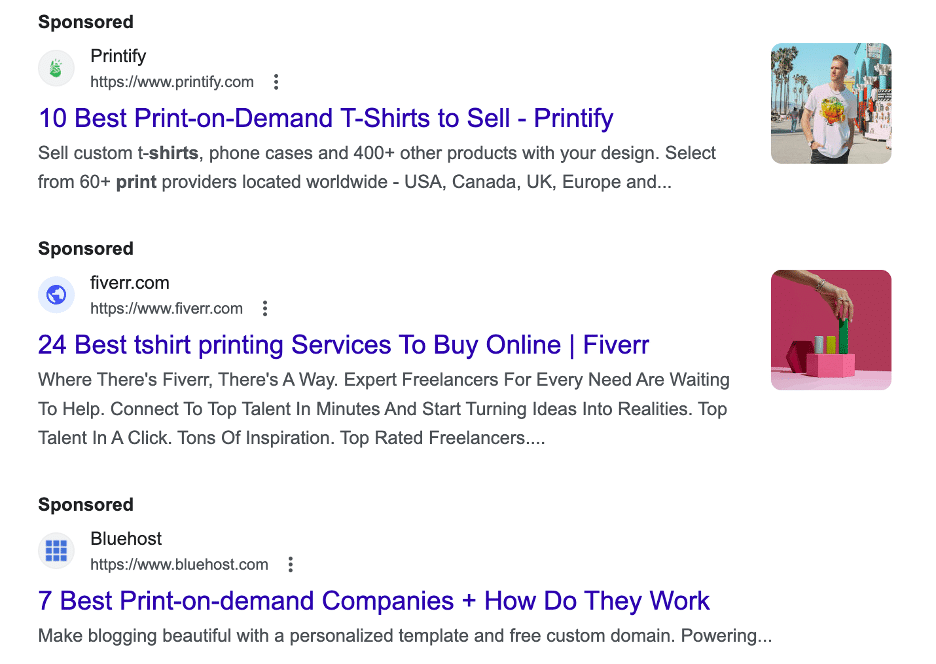
Here are several methods to promote your store.
Influencer Marketing
Collaborate with influencers with a strong following in your niche market. They can help you reach a wider audience and generate sales through endorsements and recommendations.
Paid Ads on Social Media
Platforms like Facebook, Instagram, and TikTok offer paid advertising options to target specific demographics. Create paid ads to promote your products to a larger audience and increase brand visibility.
Paid Ads on Search Engines
Platforms like YouTube, Google Ads, and Pinterest provide opportunities to run ads and target potential customers based on their search queries. Use these options to reach people actively looking for products like yours.
In-Platform Ads
If you’re selling custom products on platforms like Etsy or Amazon, take advantage of their advertising options, such as Etsy ads or Amazon PPC, to increase visibility and attract more customers within the platform.
SEO
Optimize your blog and product pages for search engines to improve your organic visibility. This involves using relevant keywords, creating high-quality content, and optimizing your website’s structure to rank higher in search results.
Email Marketing
Build an email list of potential customers and send them targeted promotional emails. Email marketing is a powerful tool for nurturing leads, driving repeat purchases, and fostering customer loyalty.
Marketplaces
Consider expanding your presence, offering your products on other marketplaces, exposing your products to a broader audience, and potentially boosting your sales.
The beauty of using Shopify is that you can sync your existing business to marketplaces like Amazon, Etsy, and eBay.
Implementing upselling and cross-selling strategies can help boost your sales. Explore Shopify apps that provide features to help you with these strategies and enhance your store’s performance.
The Pros and Cons of Starting a Print-On-Demand Business
Please create a table with the following details.
| ✅Pros | ❌Cons |
|---|---|
| Easy setup | Low profit margins |
| Product variety | High competition |
| Customization options | Inconsistent workload |
| Low investment and risks |
Pros
Easy Setup
One of the major advantages of a POD business model is its easy setup process. You don’t need to invest in bulk printing or manage inventory, making it accessible for aspiring entrepreneurs.Product Variety
With print-on-demand, you can offer a wide range of products, such as t-shirts, mugs, phone cases, tote bags, and more, and cater to various customer preferences and easily expand your product line.Customization Options
Since you can easily customize designs and products, you can create unique and personalized items, attracting customers and setting you apart from the competition.Low Investment and Risks
Unlike traditional businesses that require significant upfront investments, a POD business requires minimal costs to set up, lowering the financial risk associated with starting a new business.
Cons
Low Profit Margins
If you don’t print in bulk, the cost per unit can be higher for a print-on-demand business, reducing your profit potential.High Competition
The print-on-demand industry has grown exponentially in the last few years, leading to increased competition. You’ll need to find ways to stand out from the crowd and attract customers to your store.Inconsistent Workload
Workload and income in a POD business can be inconsistent. You may experience periods of high demand and then face slower periods. It’s crucial to set boundaries and budget accordingly based on the amount of work you anticipate.
Frequently Asked Questions (FAQs)
Is a Print-On-Demand Business Profitable?
Yes.
It allows you to start without inventory or shipping concerns, making it a low-cost option. However, your success and profitability depend on market saturation, competition, and practical strategies.
Consider costs, net income, break-even point, and profit expectations.
Continuous evaluation and adaptation are key to profitability. Monitor sales, gather feedback, and optimize your business. Stay focused, refine your offerings, and be open to new opportunities.
How Do I Make My Print-On-Demand Business Successful?
The steps I outlined above teach you how to start a successful print-on-demand business.
Here’s the condensed version.
Pick a Niche.
Select a specialized market segment to target a specific audience, reduce competition, and save on advertising costs.
Choose the Best POD Company.
Research and select a reliable print-on-demand company that offers a wide range of products beyond t-shirts to expand your product line.
Create High-Quality Designs.
Focus on crafting unique and appealing designs for your products. Start with core products and diversify with different designs to attract a broader audience.
Promote Your Products.
Utilize various social media channels and run ad campaigns to reach your target audience and increase brand exposure.
Provide Excellent Customer Service.
Prioritize exceptional customer service to build trust and loyalty among your customers. Respond to inquiries promptly and resolve any issues efficiently.
Can You Make Money With Printful?
Yes. Printful can be profitable for businesses. It offers a wide range of customizable products and integrates with various eCommerce platforms and marketplaces.
With Printful, you only pay when a customer places an order, reducing upfront costs. They also offer premium plans with additional features.
However, selling online can be challenging, and success depends on branding and marketing efforts. It’s not a get-rich-quick scheme; you must invest time and effort.
Remember that Printful’s shipping costs range from $0 to $50 per item, which you must consider when pricing your products.
Can You Make Money With Printify?
Yes, making money with Printify is possible. You can connect with on-demand printers and set up your own online store to sell custom products.
The retail prices you set for your products determine your profit. While subscription fees range from free to $29.99 monthly, you can also benefit from potential product discounts.
Learn the differences between Printify and Printful to determine which platform suits your needs.
What Are the Alternatives to the Print-On-Demand Business Model?
Here are some alternatives to the print-on-demand business model:
Traditional Manufacturing
With traditional manufacturing, you produce products in bulk and hold inventory.
This requires upfront investment in production and storage, but it allows for greater control over the manufacturing process and potentially higher margins.
Dropshipping
Dropshipping is a business model where you partner with suppliers who handle inventory and shipping. When a customer places an order on your online store, the supplier ships the product directly to the customer.
You don’t need to manage inventory, but this may result in longer shipping times and less control over product quality.
Wholesale
With the wholesale model, you buy products in bulk at a discounted price from manufacturers or distributors and then resell them at a higher price to retailers or customers.
This model requires more capital to purchase inventory but allows for greater control over pricing and branding.
White Labeling
White labeling involves rebranding and selling products manufactured by another company as your own. You can add your logo and branding to the products and sell them under your brand name.
How Much Does It Cost To Start a Print-On-Demand Business?
When launching a POD business, your costs will depend on your approach. There are two options: starting for free or investing some money.
With the free method, platforms like Shopify or WooCommerce offer limited features on their free plans, but you may need to upgrade later for more advanced capabilities.
Alternatively, investing money allows you to purchase a custom domain, premium themes, and additional apps or plugins to enhance your store’s functionality.
These investments can range from a few hundred to a few thousand dollars. Consider your budget and business needs when deciding which approach is best for you.
How Do I Start a Print-On-Demand Business With No Money?
Starting a Print-On-Demand (POD) business without money requires resourcefulness and creativity.
Here’s my brief explanation of how to start a print-on-demand business with no money.
You can begin by choosing a niche and creating unique designs using free graphic design software and stock images. Set up your online store on free eCommerce platforms like Shopify’s trial version or WooCommerce on WordPress.
Free POD services like Printful or Printify handle printing and shipping without upfront costs. Promote your products on social media and collaborate with micro-influencers for product promotion.
Offer pre-orders to cover production costs before fulfilling orders. Focus on organic growth through SEO and content marketing, and network with other entrepreneurs for insights.
As your business generates revenue, reinvest profits to upgrade your store and expand your product range. Starting with no money may take time, but you can grow your POD business with dedication without substantial upfront investment.
The Bottom Line
I hope my guide taught you how to start print-on-demand.
Don’t hesitate to use the print-on-demand tips in my guide to build a successful business from the ground up.
By understanding your target audience, utilizing platforms like Shopify or WooCommerce, and partnering with reliable print-on-demand services like Printful or Printify, you can set yourself up for success.
Focus on delivering high-quality designs and effectively promoting your products through various marketing channels, including social media.
With dedication, you can build a thriving print-on-demand business that meets your customers’ demands and achieves long-term success in the competitive e-commerce industry.

